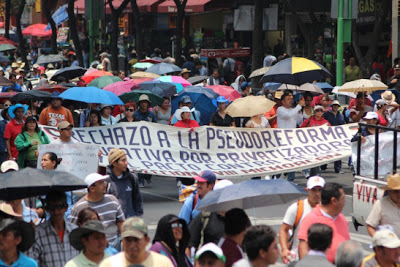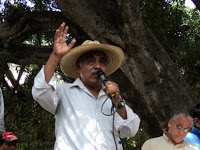 |
| Militant teachers demonstrate in Mexico City, May 15, 2013. Photo by Fritz Schtickelmeyer / MexDFmagazine. |
Marching against education ‘reforms’:
Teachers’ Day in Mexico:
Teachers who earn about $600 a month, work two jobs, and bear constant insults in the media, see that, just this one day, government and media sources thank them.
By Shirley Youxjeste | The Rag Blog | May 22, 2013
GUERRERO, Mexico — “Take a bus or taxi to the Aurrerá supermarket on Jacarandas Avenue. Walk from there because we have the streets blocked.” With these words my contact told me how to get to the starting point of Wednesday’s teachers’ march in Chilpancingo, Guerrero, Mexico.
(Chilpancingo was also the scene in April of large militant protests by teachers. Those demonstrations were met with violent response from Mexican federal police.)
The teachers’ encampment occupies about five blocks of streets in an outlying area that is home to the state education and health departments and the offices of CETEG (Coordinadora Estatal de Trabajadores de la Educación en Guerrero), the dissident (and numerically strongest) faction of the teachers’ union.
May 15 is Teachers’ Day in Mexico. It’s a frustrating day: Teachers who earn about $600 a month, work two jobs, and bear constant insults in the media, see that, just this one day, government and media sources thank them.
It’s also a day of protests. This year, teachers marched in most major cities, especially in the four adjoining southern and western states where resistance has been strongest in recent times: Guerrero, Morelos, Oaxaca, and Michoacán. But there was action in the North, too, where teachers blocked the border crossing in Tijuana for several hours.
Why so much anger? The new president and new congress rammed through a Chicago/Richard Daley/Rahm Emanuel/Arne Duncan/Barack Obama-style “reform” earlier this year and teachers are not having it.
 |
| CETEG leader Gonzalo Juárez Ocampo. |
In Guerrero, in addition to Wednesday’s march in the capital city of Chilpancingo, teachers took over city halls in Tlapa and Iguala the previous day to protest the sudden decision of local and state governments (of all parties) to “recognize” teachers’ efforts on May 15 and not, as is usually the case, on the following weekend. And the “recognition” was to take the form of a raffle of cars and, in the case of the coastal town of Zihuatenejo, even of houses.
The militant teachers took this as an attempt to buy off teachers who would otherwise attend the march.
According to Concepción Nieves, a regional representative of the CETEG from Ciudad Altamirano, Wednesday’s march was planned more as commemorative than as a heavy protest, given that “Guerrero has given all it can give” — highways blocked, teachers and their supporters beaten by federal, state, and local police, headquarters of the four major political parties damaged by teachers in retaliation, four leaders briefly imprisoned hundreds of miles away, and weeks without classes.
The idea was to hold an assembly afterwards to determine the future of the movement and coordinate and expand it to the national level. At the end of the march, instead of receiving government “incentive” bribes, teachers partook of a feast provided by parents.
On Tuesday, teachers received indirect support from an unlikely source: conservative hotel and restaurant owners angry because when the federal government lodged more than 2,000 troops (federal police in Mexico are soldiers with different uniforms) in local hotels during the peak months of “unrest,” no one paid the bill, and owners allege damage to rooms and maltreatment of their employees.
Meanwhile, a few days later, president Enrique Peña Nieto, never one to miss an opportunity, cut the ribbon for “the world’s largest instant coffee processing plant,” owned by Nestlé.
[Shirley Youxjeste is a retired teacher from Wisconsin who now lives in rural Mexico.]

















